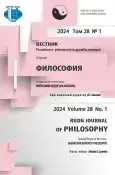Буддийские перспективы в отношении смерти
- Авторы: Гокхале П.П.1
-
Учреждения:
- Центральный университет тибетологии
- Выпуск: Том 28, № 1 (2024): ФИЛОСОФИЯ БУДДИЗМА МАХАЯНЫ
- Страницы: 37-46
- Раздел: ФИЛОСОФИЯ БУДДИЗМА МАХАЯНЫ
- URL: https://journal-vniispk.ru/2313-2302/article/view/325443
- DOI: https://doi.org/10.22363/2313-2302-2024-28-1-37-46
- EDN: https://elibrary.ru/DLCJEE
- ID: 325443
Цитировать
Полный текст
Аннотация
Рассмотрены некоторые из центральных вопросов, касающихся понятия смерти, обсуждаемых в тхераваде (палийском буддизме), а также в буддизме махаяны. В каком смысле смерть рассматривается как пример духкхи (санскрит) или дуккхи (пали)? Утверждается, что, во-первых, слово духкха/дуккха ( duḥkha/dukkha ) используется как прилагательное («неудовлетворительный»), а не как существительное («боль» или «страдание»). Во-вторых, под смертью Будда подразумевает не сам акт умирания, а переживание кем-то смерти или саму идею смерти. Будда также говорит о бессмертии как о цели. Для него бессмертие означает не признание чего-то вечным, а развитие правильного отношения к смерти с помощью таких медитаций, как медитация о нечистоте ( аśubhabhāvanā ) и медитация созерцания умирания ( maraṇānussati ). Если прекращение цикла перерождений и повторных смертей ( punarmṛtyu ) -так часто обозначают сансару) является конечной целью, которую достигает архат, то это должно относиться и к Татхагате. В таком случае возникает проблема: каким образом вопрос о существовании Татхагаты после смерти может считаться неразрешимым ( avyākṛṭa )? Автором высказано мнение, что причиной неразрешимости этой проблемы является глубокая, неизмеримая, непостижимая природа, приписываемая Татхагате. Также обсуждено основное различие между отношением к смерти в шравакаяне и махаяне. Наконец, рассматрен вопрос о том, допустимо ли в буддизме прекращение собственной жизни при определенных условиях.
Ключевые слова
Об авторах
Прадип П. Гокхале
Центральный университет тибетологии
Автор, ответственный за переписку.
Email: pradeepgokhale53@gmail.com
профессор, отдел исследований Индия, 221007, Сарнатх, ул. Мавайя, д. 1
Список литературы
- Walshe M. The Long Discourses of the Buddha: A Translation of the Dīghanikāya. Nikaya D, transl. Boston: Wisdom Publications; 1995.
- Buddhaghosa.Visuddhimagga. In 2 vols. London: Pali Text Society; 1920-1921.
- Mullin GH. Death and Dying: The Tibetan Tradition. New York: Arkana Paperbacks, Toutledge and Kegan Paul Inc; 1986.
- Davids TWR, Oldenberg H, transl. Vinayapiṭaka. In: Sacred Books of the East. Pt. I. Delhi: Motilal Banarsidass; 1974.
- Bhikkhu Ñ, Bhikkhu B, transl. The Middle Length Discourses of the Buddha. Boston: Wisdom Publications; 1995.
- Davids TWR, transl. The Questions of King Milinda (Milindapañhapāli). Part I. Delhi: JP Publishing House; 2013.
- Vaidya PL, editor. Madhyamakaśāstra of Nāgārjuna with the Commentary Prasannapadā by Candrakīrti. Darbhanga: The Mithila Institute; 1960.
- Williams P. Mahāyāna Buddhism: The Doctrinal Foundations. New York: Routledge; 1989.
- Lalmani J. Studies in the Buddhistic Culture of India. Delhi: Motilal Banarsidass; 1967.
- Gowans KW. Buddhist Moral Philosophy: An Introduction. New York: Routledge; 2015.
Дополнительные файлы









